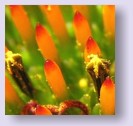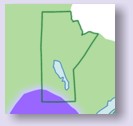
The Biology of Narrow-leaved Purple Coneflower (Echinacea angustifolia)There are many kinds of wildflowers that share the common name "Coneflower", including plants in the genera: Dracopis, Echinacea, Rudbeckia and Ratibida.The genus Echinacea, considered to be the "true" coneflowers, is limited to North America, at least as far as the original range of these plants. Narrow-leaved Purple Coneflower (Echinacea angustifolia, NLPC for short) is one of nine species of of coneflowers found in North America and is the only species native to Manitoba. (Click thumbnail images to see larger images.) Description
Life Cycle
HabitatNLPC is found in mixed grass prairies in Manitoba. Mixed grass prairie is found in southwestern Manitoba on drier, well-drained soils. The dominant grasses in the mixed grass prairie include Little Bluestem, Spear Grass, Side-Oats Grama and Blue Grama. For more in NatureNorth on Manitoba's mixed grass prairie follow this link: Click Here.
|
| Kingdom: |
Plantae |
|
| Division: |
Magnoliophyta |
|
| Class: |
Magnoliopsida |
|
Order: |
Asterales |
|
| Family: |
Asteraceae |
|
Tribe |
Heliantheae |
|
| Genus: |
Echinacea |
|
| Species: |
angustifolia |
Name
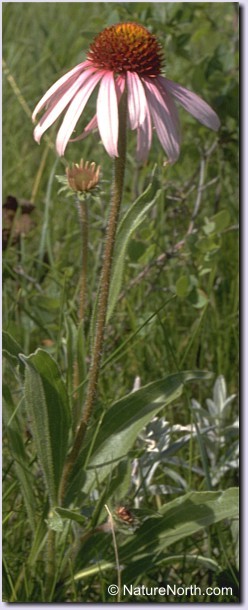 In
addition to being known as Narrow-leaved Purple Coneflower this plant
is also called: Black Sampson, Kansas Snakeroot and Narrow-leaf Echinacea.
The common name used in Manitoba refers to the relatively narrow, elongate
leaves of this species. The "Purple" part of the common name
is pretty obvious. The general name for this group of plants, "Coneflower",
derives from both the shape of the main flower head, plus the fact that
the purple petals tend to reflex downward making the entire flower appear
cone-shaped.
In
addition to being known as Narrow-leaved Purple Coneflower this plant
is also called: Black Sampson, Kansas Snakeroot and Narrow-leaf Echinacea.
The common name used in Manitoba refers to the relatively narrow, elongate
leaves of this species. The "Purple" part of the common name
is pretty obvious. The general name for this group of plants, "Coneflower",
derives from both the shape of the main flower head, plus the fact that
the purple petals tend to reflex downward making the entire flower appear
cone-shaped.
The genus name, Echinacea, comes from the Greek "echinos", or hedgehog, for the spiny nature of the flower heads. The species name, angustifolia, derives from the latin "angust", meaning narrow and "foli" meaning leaf.
Uses
Though the entire plant of Purple Coneflower may be used medicinally, it is primarily the roots that are used. Aboriginal peoples on the North American prairies used this plant widely to treat pain (as an anesthetic), coughs and colds, and even snake bite. European settlers quickly added this species to their folk medicine and used it to treat many ailments in people and livestock. Modern research has shown that Echinacea's in general contain a variety of useful compounds. Consuming extracts of Echinacea has genuine efficacy in minimizing the effects of colds and flu's, both in helping prevent initial infections and reducing lengths of suffering. Echinacea extracts are marketed primarily as immuno-stimulants to help prevent colds and flu's.
NLPC is considered to have the greatest potency of all the Coneflowers, as far as its medicinal benefits go. For an in-depth review of the ethnobotany of this plant check out the book: Medicinal Wild Plants of the Prairie: An Ethnobotanical Guide by Kelly Kindscher (1992).
Active Compounds
There is a complex array of chemicals found in Echinacea plants. There are really too many to discuss here. See the "Germ Plasm" and "Emedicinal" links at the bottom of this page for more phytochemical information. The chemicals thought to produce the medicinal benefits are thought to be various phenols. In herbal remedies it is the amounts of phenols present that can denote the quantity of raw Echinacea. Other chemicals that may be important in the efficacy of Echinacea include alkylamides and polysaccharides.
Commercial Production
Echinacea is now being grown as a commercial crop in parts of Europe and North America. Some proponents suggest that growers can make as much as $10,000/ha ($4000/acre), but widely fluctuating world markets for herbal remedies could make farming Echinacea a chancy crop. There's a couple of great links below if you're interested in more on commercial production.
Use With Caution!
Be careful if you are self-medicating with Echinacea, or any other herbal medicinals. Even "natural" chemicals can interact with other medications you may be taking, or you may find yourself allergic to some compounds. Various adverse side effects have been noted from ingesting Echinacea, though most are very infrequently reported. Be sure to let you doctor know if you are taking Echinacea in conjunction with any prescribed medications.
In the Garden
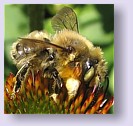 Coneflowers
of all sorts are wonderful garden perennials. Not only are they hardy
and showy with large flowers that last for several weeks, but they are
great nectar sources for insects. Bees and butterflies will swarm any
open blossoms. Purple Coneflowers are a must in any butterfly garden.
Coneflowers
of all sorts are wonderful garden perennials. Not only are they hardy
and showy with large flowers that last for several weeks, but they are
great nectar sources for insects. Bees and butterflies will swarm any
open blossoms. Purple Coneflowers are a must in any butterfly garden.
North America's coneflowers, along with many other native prairie wildflowers,
were snapped up by horticulturists and domesticated for garden use.
Several of North America's purple coneflower species have been turned
into popular garden perennials. Probably the most widespread of these
is Echinacea purpurea, which has at least 13 named varieties,
including one with white-petals ("White Swan") and another
with bright red petals ("Rubinstern"). With increasing interest
being shown in using native plants in gardening and landscaping the
use of Echinacea's has increased dramatically in the last few decades.
Many people now seek out "wild type" plants to use in their
gardens.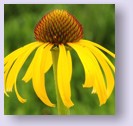
Grow Your Own
Horticultural varieties of Echinacea pupurea are readily available as both seeds and live plants from gardening centres, and they do well in gardens in southern Manitoba.
If you want some genuine Manitoba Purple Coneflowers (Echinacea angustifoia), they are available locally. But please, don't dig them from the wild! With their large tap roots they don't transplant well and they deserve to be left where they are, in the wild. If you must have something from the wild, collect a few seeds in late September or October and grow your own. Place the seeds in some damp sand in a small bag or container and put them in your fridge for the winter. In spring, plant the seeds in a sandy soil mix in pots or right into you garden. Be patient though, as it will take a couple of years before your plants will be large enough to flower.
Manitobans can get seeds of NLPC from Winnipeg's Living Prairie Museum. You can buy plants from Prairie Originals, e-mail prairieoriginals@mts.net or from PrairieFlora, email prairieflora@mts.net.
Final Thoughts
Narrow-leaved Purple Coneflower is another example of a plant species that has benefits for humans. Who knows what beneficial compounds or medicines may someday be refined from this plant. Aboriginal peoples considered this one of their most important medicinal herbs. We really ought to keep it around, growing wild in Manitoba's mixed grass prairies. It would be a shame, if like the bison, Coneflowers ceased to be found in the wild in this prairie province.
- Johnny Caryopsis -
If you enjoyed this article you might also like:
St. John's Wort | Giant Hyssop | Summer Fruits | Poison Ivy
Recommended Readings
Here's some good web resources on Echinacea:
Echinacea - Wikipedia | Germplasm Resources Information Network - Echinacea angustifolia | Emedicinal - Echinacea
Ag Canada Production Practices - Echinacea | Echinacea as an Alternative Crop | Echinacea Production in Manitoba
Return to: Our Purple Coneflower | Summer Issue | NatureNorth Front page

